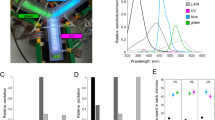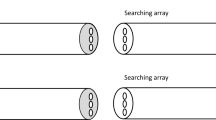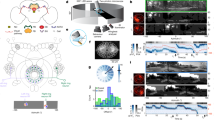Abstract
MANY hymenopterans use visual landmarks to guide the last stages of their return to a familiar place, moving so that the pattern of landmarks imaged on their retina matches the pattern stored on previous visits to that place1,2. What is the coordinate frame of these landmark memories, and how is it established? On the one hand, bees and flies learn complex visual shapes retinotopically3,4, and landmark memories probably share this characteristic. On the other hand, bees record the position of landmarks in compass coordinates. Thus, Lindauer5 showed that bees that had been trained to feed at the southernmost corner of a square table recognized the corner by its compass bearing from the table's centre. Taken together, these results suggest that these insects place retinotopically localized memories in Earth-based coordinates. We report here that honeybees accomplish this very simply: when learning about or searching for a goal, they face consistently in one compass direction, aided by the Earth's magnetic field. We suggest that the main benefit of inspecting the world from one favoured direction is to simplify the storage and retrieval of retinotopic memories.
This is a preview of subscription content, access via your institution
Access options
Subscribe to this journal
Receive 51 print issues and online access
$199.00 per year
only $3.90 per issue
Buy this article
- Purchase on Springer Link
- Instant access to full article PDF
Prices may be subject to local taxes which are calculated during checkout
Similar content being viewed by others
References
Wehner, R. in Handbook of Sensory Physiology vol. VII/6C (ed. Autrum, H. J.) 287–616 (Springer, Berlin, 1981).
Collett, T. S. Phil. Trans. R. Soc. Lond. B337, 295–303 (1992).
Wehner, R. J. comp. Physiol. 77, 256–277 (1972).
Dill, M., Wolf, R. & Heisenberg, M. Nature 365, 751–753 (1993).
Lindauer, M. Cold Spring Harb. Symp. quant. Biol. 25, 371–377 (1960).
Batschelet, E. Circular Statistics in Biology (Academic, London, 1981).
Opfinger, E. Z. vergl. Physiol. 15, 431–487 (1931).
Couvillon, P. A. & Bitterman, M. E. J. Insect Behav. 5, 123–129 (1992).
Lehrer, M. J. comp. Physiol. A172, 549–563 (1993).
Tinbergen, N. Z. vergl. Physiol. 16, 305–335 (1992).
Zeil, J. J. comp. Physiol. A172, 189–205 (1993).
Zeil, J. J. comp. Physiol. A172, 207–222 (1993).
von Frisch, K. The Dance Language and Orientation of Bees (Belknap, Cambridge, 1967).
Wehner, R. & Rossel, S. in Experimental Behavioral Ecology and Sociobiology (eds Hölldobler, B. & Lindauer, M.) 11–53 (Sinauer, Sunderland, 1985).
Lindauer, M. & Martin, H. Z. vergl. Physiol. 60, 219–243 (1968).
Martin, H. & Lindauer, M. J. comp. Physiol. 122, 145–187 (1977).
Gould, J. L. Kirschvink, J. L. & Deffeyes, K. S. Science 201, 1026–1028 (1978).
Walker, M. M. & Bitterman, M. E. J. exp. Biol. 145, 489–494 (1989).
Kirschvink, J. L. & Kobayashi-Kirschvink, A. Am. Zool. 31, suppl. (1), 169–185 (1991).
Schmitt, D. E. & Esch, H. E. Naturwissenschaften 80, 41–43 (1993).
Vollbehr, J. Zool. Jb. Physiol. 79, 33–69 (1975).
Author information
Authors and Affiliations
Rights and permissions
About this article
Cite this article
Collett, T., Baron, J. Biological compasses and the coordinate frame of landmark memories in honeybees. Nature 368, 137–140 (1994). https://doi.org/10.1038/368137a0
Received:
Accepted:
Issue Date:
DOI: https://doi.org/10.1038/368137a0
This article is cited by
-
Scientific evidence invalidates health assumptions underlying the FCC and ICNIRP exposure limit determinations for radiofrequency radiation: implications for 5G
Environmental Health (2022)
-
Orientations and water dynamics of photoinduced secondary charge-separated states for magnetoreception by cryptochrome
Communications Chemistry (2021)
-
Magnetoreception in Hymenoptera: importance for navigation
Animal Cognition (2020)
-
For humans navigating without vision, navigation depends upon the layout of mechanically contacted ground surfaces
Experimental Brain Research (2020)
-
Multimodal interactions in insect navigation
Animal Cognition (2020)
Comments
By submitting a comment you agree to abide by our Terms and Community Guidelines. If you find something abusive or that does not comply with our terms or guidelines please flag it as inappropriate.



